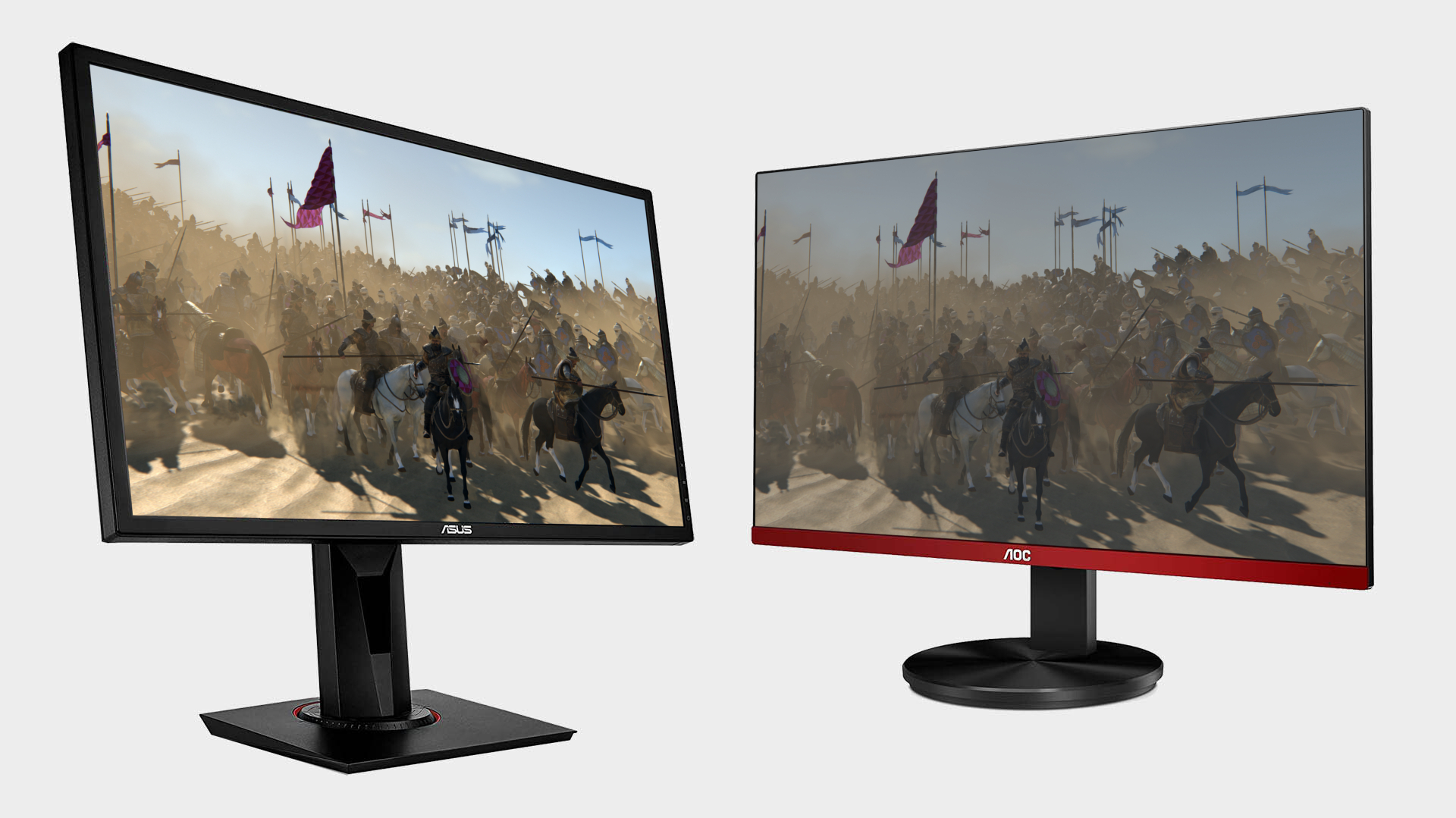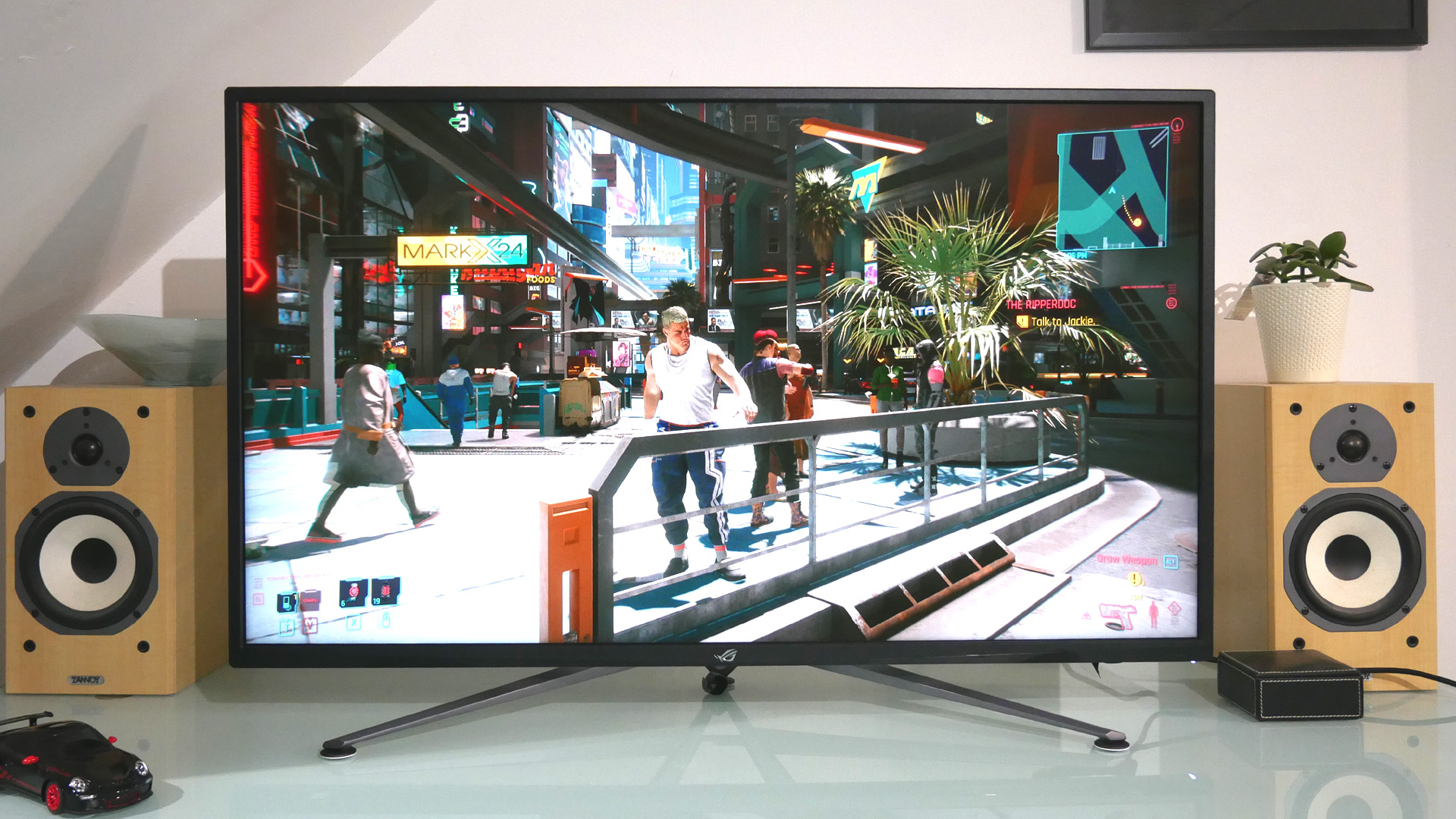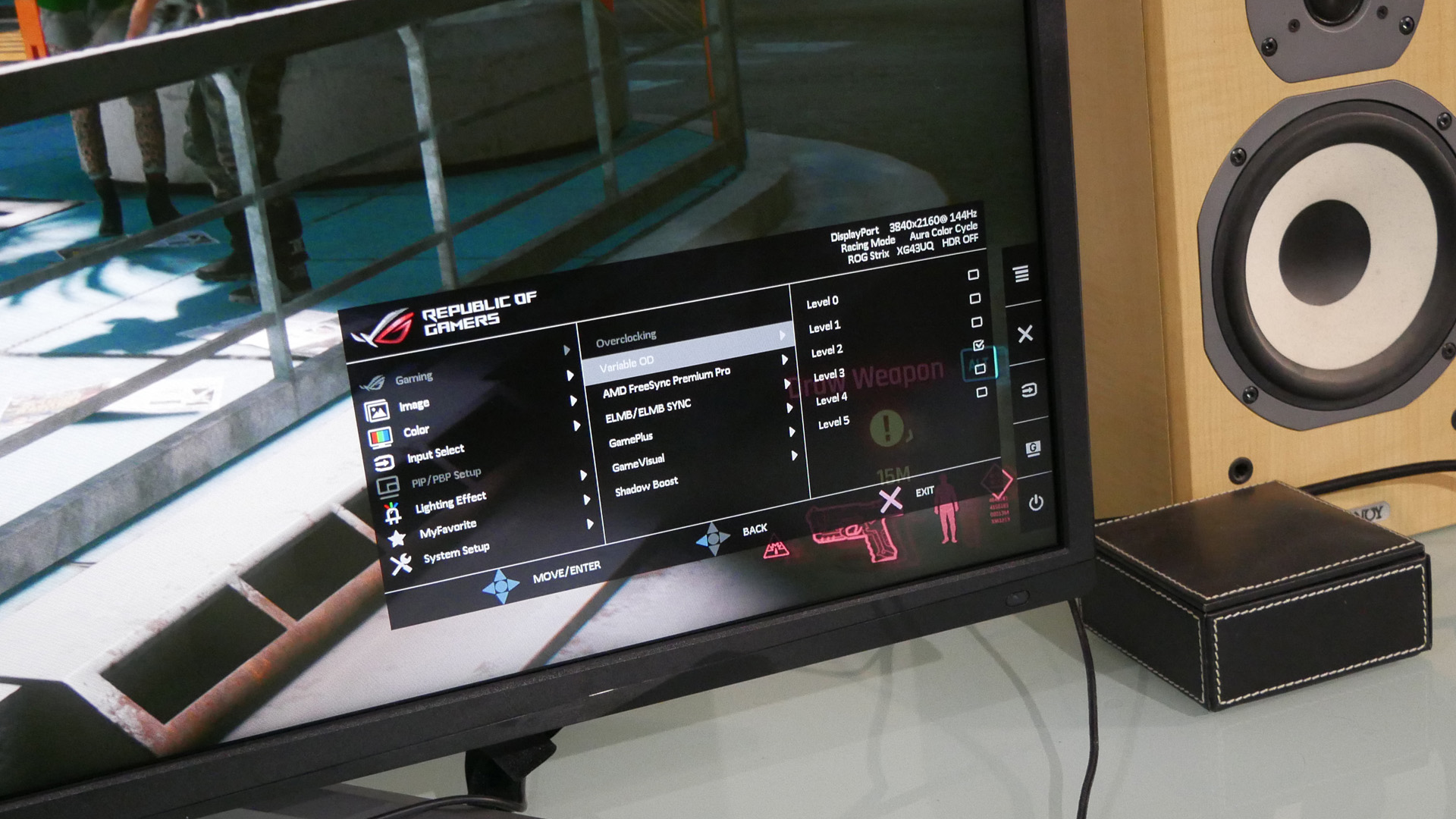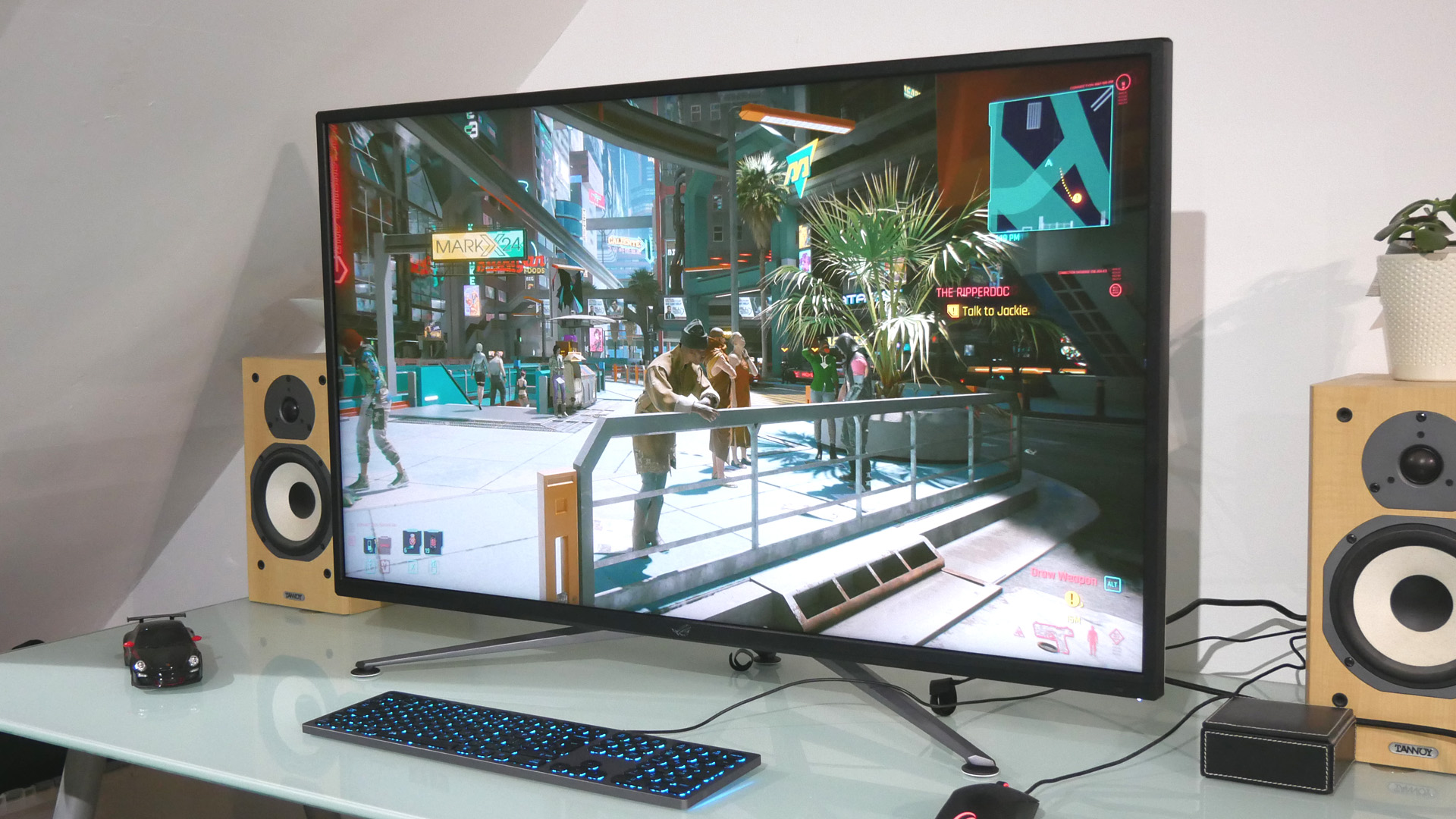Our Verdict
Asus’s new 43 incher is an absolute beast, cranking out 1,000 nits of brightness from its stunning 43-inch 4K panel. But the poor pixel response is actually unforgivable
For
- Uber punchy 1000 nit brightness
- Strong colours and contrast
- 4K plus 144Hz and HDMI 2.1
Against
- Terrible pixel response
- Edge-lit local dimming
- BRG pixels can be problematic
PC Gamer's got your back
Remember when VA was the panel technology that dare not speak its name for gaming? Long story short, you had a choice between unsightly smears or hideous levels of overdrive-induced pixel overshoot. Yuck. Either way, the pixel response was often ugly.

Best gaming monitor: pixel-perfect panels for your PC
Best high refresh rate monitor: screaming quick screens
Best 4K monitor for gaming: when only high-res will do
Best 4K TV for gaming: big-screen 4K PC gaming
Recently, several gaming monitor makers, including Samsung, have put all that comprehensively to bed. VA monitors can be properly quick. Hold that thought as we invite the epic new ASUS ROG Strix XG43UQ to enter the scene. This thing is a beast.
The vital stats begin with the massive 43-inch 4K panel, all 3,840 by 2,160 pixels of it. It’ll do fully 144Hz, which is not exactly unique these days, but still impressive when combined with 4K. More unusually, it’ll run high refresh rates via not only DisplayPort but also HDMI. It includes a pair of HDMI 2.1 sockets that support 120Hz at 4K.
That’s most obviously optimal for console gaming. But it also gives you more options for hooking up a PC, albeit only the latest unobtainium Nvidia RTX 30-series and AMD RX 6000 boards support HDMI 2.1. The use case here is tag-teaming your PC with an Xbox Series X or Sony PS5.

Anyway, you also get all the variable refresh rate support you can eat, with both AMD FreeSync and Nvidia G-Sync support in the mix, plus VRR compatibility for those pesky consoles. Next up, the ASUS ROG Strix XG43UQ cranks out a peak brightness of fully 1,000 nits and sports VESA DisplayHDR 1000 certification. Looking for a monitor to burn you a new set of peepers? This Asus monster is surely a prime candidate.
Oh, and it’s all powered by a VA panel rated at 1ms for pixel response. Combine that response with the 144Hz refresh and it not only all bodes well regarding speed it also implies that this is one of that brave new generation of quick VA panels. Add in the fairly funky if inevitably overtly gamery design vibe, and this is an awfully promising package.
Screen size: 43-inch
Panel technology: VA
Native resolution: 3840 x 2160
Aspect ratio: 16:9
Refresh rate: 144 Hz
Response tune: 1ms MPRT
HDR: VESA DesplayHDR 1000
Contrast: 4,000:1
Color: 90% DCI-P3
Brightness: 1,000 nits
Connections: 2x HDMI 2.1, 2x HDMI 2.0, DisplayPort 1.4
Other: G-Sync Compatible, FreeSync Premium Pro, 2x USB 3.0
Unfortunately, it’s also fatally flawed. The first snag involves HDR performance. Despite the sheer 1,000 nit backlight power and the HDR1000 rating, this is not a true HDR monitor. How so? It’s down to the local dimming, a feature which the ASUS ROG Strix XG43UQ offers only in name.
Asus doesn’t quote the precise number of zones, probably because this is an edge-lit monitor and the number won’t be impressive—something in the region of eight to 16. In other words, it doesn’t have a full array backlight and the dimming is ultimately pretty pointless. In mitigation, the VA panel has super-strong inherent contrast of 4,000:1. So, as non-genuine HDR monitors go, the dynamic range is actually pretty good. But it’s a real disappointment to find an HDR1000 monitor that lacks full-array dimming.
Of course, treated as a seriously punchy SDR monitor, the ASUS ROG Strix XG43UQ would still have plenty to offer. It is incredibly bright with strong colours and excellent contrast. CyberPunk 2077 run at full reheat is absolutely spectacular. Save for one fairly serious problem. Pixel response.

Asus has included no fewer than five levels of user-configurable pixel overdrive to choose from in the OSD menu. Part of the problem is that by level three, overshoot and inverse ghosting is a fairly obvious problem. By level five, it’s catastrophic. On the other hand, knock the overdrive down or off completely and the response is very poor, with plenty of obvious blurring. It’s not even terribly good with the overdrive cranked up. There are five-year-old VA monitors with better response than this. I should know, I have one.
As a last resort, you could try Asus ELMB or Extreme Low Motion Blur technology. But instead of fixing things, it simply makes a triple-visioned mess of the XG43UQ’s image quality. It’s a pretty hopeless, pointless feature on this particular panel. If you’re wondering how all this is possible given the 1ms response spec, well, that’s an MPRT figure—that stands for Moving Picture Response Time by the way. Despite the fact that MPRT is a measure of response that’s intended to give a better real-world idea of panel performance, in practice it’s often very misleading. It certainly is here.
If all that wasn’t bad enough, the ASUS ROG Strix XG43UQ also uses a BGR rather than RGB subpixel layout. Admittedly, that doesn’t matter much for games. But it does impact font rendering in Windows, which relies on conventional subpixel structure for its ClearType font smoothing tech. It also implies this monitor is based on what is really an HDTV panel and an elderly one at that.

All of which means, unfortunately, that the ASUS ROG Strix XG43UQ is an unusually and ultimately fatally flawed gaming monitor. It’s a pity, because the static image quality is actually pretty stunning, despite the arguable fakery of the HDR certification. But the poor pixel response is unforgivable on a gaming monitor of any kind, much less one this expensive.
Asus’s new 43 incher is an absolute beast, cranking out 1,000 nits of brightness from its stunning 43-inch 4K panel. But the poor pixel response is actually unforgivable

Jeremy has been writing about technology and PCs since the 90nm Netburst era (Google it!) and enjoys nothing more than a serious dissertation on the finer points of monitor input lag and overshoot followed by a forensic examination of advanced lithography. Or maybe he just likes machines that go “ping!” He also has a thing for tennis and cars.


